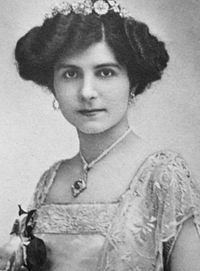House Karadordevic Name Princess of | ||
 | ||
Issue Prince Vsevolod IvanovichPrincess Catherine Ivanovna Children Prince Vsevolod Ivanovich of Russia, Princess Catherine Ivanovna of Russia Parents Peter I of Serbia, Princess Zorka of Montenegro Siblings Alexander I of Yugoslavia, George, Crown Prince of Serbia, Andrija Karadordevic, Milena Karadordevic Similar People Prince John Konstanti, Princess Zorka of Montenegro, Peter I of Serbia, Alexander I of Yugoslavia, George - Crown Prince of | ||
Princess helen of serbia princess elena petrovna of russia
Jelena Karadordevic or Princess Helen of Serbia (4 November 1884 – 16 October 1962) was the daughter of King Peter I of Yugoslavia and his wife Princess Zorka of Montenegro. She was the elder sister of George, Crown Prince of Serbia and King Alexander I of Yugoslavia. Helen was also a niece of Anastasia of Montenegro (or "Stana"), wife of Grand Duke Nicholas Nikolaevich of Russia, and of Milica of Montenegro, wife of Grand Duke Peter Nicolaievich of Russia, the women who introduced Grigori Rasputin to Tsarina Alexandra. She was born Princess Jelena Karadordevic, became Princess Jelena of Serbia at the accession of her father and was known as Elena Petrovna, Jelena Petrovna, Helene Petrovna or Ellen Petrovna after her marriage.
Contents
- Princess helen of serbia princess elena petrovna of russia
- Princess Helen of Serbia Princess Elena Petrovna of Russia
- Early life
- Engagement and marriage
- Revolution
- Imprisonment
- Exile
- References
Princess Helen of Serbia, Princess Elena Petrovna of Russia
Early life
The strong-minded, purposeful Helen, whose mother died when she was a small child, was brought up largely under the care of her aunts Stana and Milica and educated in Russia at the Smolny Institute, a school in St. Petersburg for well-born girls. "She was a very sweet-faced though plain girl, with beautiful dark eyes, very quiet and amiable in manner," wrote Margaretta Eagar, governess to the daughters of Tsar Nicholas II. Eagar wrote that Helen, then about seventeen, often came to tea with another of her aunts, Princess Vera of Montenegro, and cousins. Young Grand Duchess Olga Nikolaevna of Russia was very fond of her.
Engagement and marriage
A fourth aunt, Elena of Montenegro, Queen of Italy, invited her for a visit and introduced her to Prince John Constantinovich of Russia. He proposed marriage soon after. It was a love match, a surprise to the family because the gentle, introverted John had thought of becoming a Russian Orthodox monk. "Perhaps you know that Ioanchik is engaged to Helene of Serbia, it is so touching," wrote his distant cousin, 14-year-old Grand Duchess Tatiana Nikolaevna of Russia, to her aunt, Grand Duchess Olga Alexandrovna of Russia, on 14 July 1911. "How funny if they might have children, can they be kissing him? What foul, fie!" The couple married on 21 August 1911, in St. Petersburg, Russia.
Helen studied medicine at the University of St. Petersburg following their marriage, a career pursuit she had to give up when she gave birth to her first child. The couple had two children, Prince Vsevelod Ivanovich ( 20 January 1914 – 18 June 1973), and Princess Catherine Ivanovna born in Pavlovsk on ( 12 July 1915 - died in Montevideo, Uruguay on 14 July 2007). The three children and seven grandchildren of her daughter Princess Catherine, who married and later separated from Marchese Farace di Villaforesta, are the only great-grandchildren of Grand Duke Constantine Constantinovich of Russia and his wife Grand Duchess Elisabeth Mavrikievna.
Revolution
Helen voluntarily followed her husband into exile when he was arrested following the Russian Revolution of 1917 and tried to obtain his release. John was imprisoned first at Yekaterinburg, Siberia and later moved to Alapaevsk, a town in Sverdlovsk Oblast, Russia, by the Bolsheviks, where he was murdered on 18 July 1918 along with Grand Duchess Elizabeth Fyodorovna, Grand Duke Sergei Mikhailovich; John's brothers Constantine Constantinovich and Igor Constantinovich, his distant cousin Prince Vladimir Pavlovich Paley; Grand Duke Sergei's secretary, Fyodor Remez; and Varvara Yakovleva, a sister from the Grand Duchess Elizabeth's convent. They were herded into the forest by the local Bolsheviks, pushed into an abandoned mineshaft and grenades were then hurled into the mineshaft.
Imprisonment
In June 1918, Helen visited the Ipatiev House and demanded to see the tsar, secretly hoping to pass on letters to the imperial family from their relatives. After being refused entry by the guards (who had their rifles aimed at her), she went to the Amerikanskaya Hotel half a mile away, making repeated enquiries to the Cheka. She was however arrested by the secret police and imprisoned herself in Perm. John had persuaded Helen to leave Alapaevsk and go back to their two young children, whom she had left with John's mother, Grand Duchess Elizabeth Mavrikievna of Russia. During her imprisonment, the Bolsheviks brought a girl who called herself Anastasia Romanova to her cell and asked her if the girl was Grand Duchess Anastasia Nikolaevna of Russia, the daughter of Tsar Nicholas II. Helen said she didn't recognize the girl and the guards took her away. Helen was put on a train back to Petrograd two weeks later.
Exile
Swedish diplomats obtained permission for Helen's mother-in-law Grand Duchess Elizaveta Mavrikievna to leave Russia with Helen's children, Vsevelod and Catherine, and her own two younger children, Prince George Constantinovich and Princess Vera Constantinovna, in October 1918 aboard the Swedish ship Angermanland. Helen remained imprisoned at Perm until Norwegian diplomats located her and had her transferred. She was then kept prisoner at the Kremlin Palace before finally being allowed to leave and join her children in Sweden.
Helen eventually settled at Nice, France. She never remarried.
